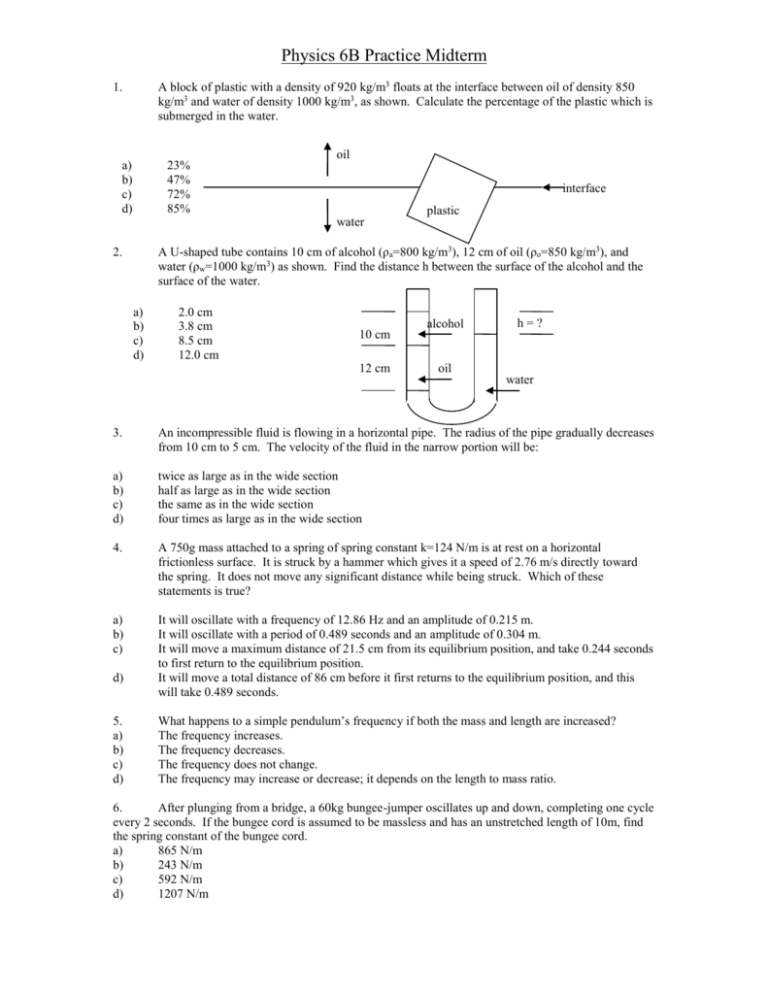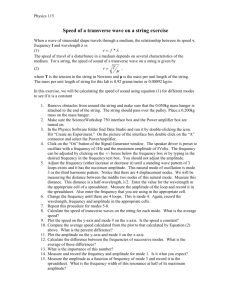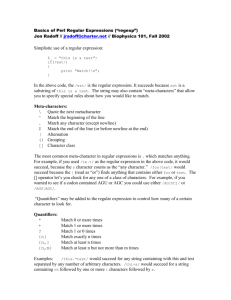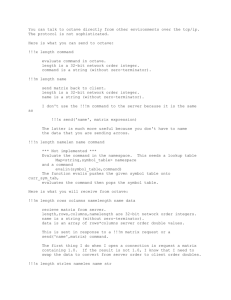Physics 6B Practice Questions
advertisement

Physics 6B Practice Midterm A block of plastic with a density of 920 kg/m3 floats at the interface between oil of density 850 kg/m3 and water of density 1000 kg/m3, as shown. Calculate the percentage of the plastic which is submerged in the water. 1. a) b) c) d) 23% 47% 72% 85% oil interface plastic water A U-shaped tube contains 10 cm of alcohol (ρa=800 kg/m3), 12 cm of oil (ρo=850 kg/m3), and water (ρw=1000 kg/m3) as shown. Find the distance h between the surface of the alcohol and the surface of the water. 2. a) b) c) d) 2.0 cm 3.8 cm 8.5 cm 12.0 cm 10 cm 12 cm alcohol h=? oil water 3. An incompressible fluid is flowing in a horizontal pipe. The radius of the pipe gradually decreases from 10 cm to 5 cm. The velocity of the fluid in the narrow portion will be: a) b) c) d) twice as large as in the wide section half as large as in the wide section the same as in the wide section four times as large as in the wide section 4. A 750g mass attached to a spring of spring constant k=124 N/m is at rest on a horizontal frictionless surface. It is struck by a hammer which gives it a speed of 2.76 m/s directly toward the spring. It does not move any significant distance while being struck. Which of these statements is true? a) b) c) It will oscillate with a frequency of 12.86 Hz and an amplitude of 0.215 m. It will oscillate with a period of 0.489 seconds and an amplitude of 0.304 m. It will move a maximum distance of 21.5 cm from its equilibrium position, and take 0.244 seconds to first return to the equilibrium position. It will move a total distance of 86 cm before it first returns to the equilibrium position, and this will take 0.489 seconds. d) 5. a) b) c) d) What happens to a simple pendulum’s frequency if both the mass and length are increased? The frequency increases. The frequency decreases. The frequency does not change. The frequency may increase or decrease; it depends on the length to mass ratio. 6. After plunging from a bridge, a 60kg bungee-jumper oscillates up and down, completing one cycle every 2 seconds. If the bungee cord is assumed to be massless and has an unstretched length of 10m, find the spring constant of the bungee cord. a) 865 N/m b) 243 N/m c) 592 N/m d) 1207 N/m 7. A 50kg block is placed at the top of a cylindrical steel pole with a radius of 0.1m and a height of 1m. Determine the change in the length of the pole. The elastic (Young’s) modulus for steel is 200x109 N/m2. a) 78 nm b) 23 nm c) 156 nm d) 47 nm 8. a) b) c) d) 9. a) b) c) d) 10. a) b) c) d) 11. a) b) c) d) You are in the front row of the Boombox Orchestra concert, standing 1m away from the speakers. The sound intensity level is an earsplitting 120 db, so you decide to move away to a quieter position. How far away from the speaker do you need to be so that the level is only 80 db? 10m 40m 100m 200m A loudspeaker playing a constant frequency tone is dropped off a cliff. As it accelerates downward, a person standing at the bottom of the cliff will hear a sound of: increasing frequency and decreasing amplitude constant frequency and increasing amplitude increasing frequency and increasing amplitude decreasing frequency and constant amplitude A “boat” consists of a massless hollow cube of side length 50cm, floating in a freshwater lake. When a person steps onto the “boat” it sinks down 30cm. Find the weight of the person. 500 N 750 N 1000 N 1500 N Two strings on the same guitar (same length) are tuned so that string B is one octave higher frequency than string A. Given that string A has 4 times the mass of string B, what is the ratio of the tensions in the strings? (Hint: One octave higher frequency means the frequency is twice as high). String A has 4 times the tension of String B String A has 2 times the tension of String B The tensions in the strings are equal String A has half the tension of String B 12. One of the harmonics on a string that is 1.30 m long has a frequency of 15.60 Hz. The next higher harmonic has frequency 23.40 Hz. Find the fundamental frequency and the speed of the waves on the string. a) 7.80 Hz, 20.3 m/s b) 15.6 Hz, 24.3 m/s c) 23.4 Hz, 9.8 m/s d) 39.0 Hz, 20.3 m/s 13. Two protons are placed as follows: Proton A is placed on the X-axis, +5 cm from the origin. Proton B is placed on the Y-axis, +10 cm from the origin. Find the electric field at the origin (magnitude and direction). The charge on a proton is 1.6 x 10 -19C. 7.2 x 10-7 N/C, 14° below negative x-axis 5.9 x 10-7 N/C, 14° above positive x-axis 7.2 x 10-7 N/C, 76° above positive x-axis 5.9 x 10-7 N/C, 14° below negative x-axis a) b) c) d) Answers: 1)b 2)b 3)d 4)c 5)b 6)c 7)a 8)c 9)c 10)b 11)c 12)a 13)d











